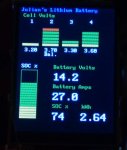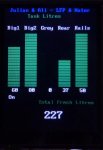Stafford
Member
Whats the best wAy to charge a 12v LiFePo4 battery bank from my isuzu NPS 24v alternator?
Battery manufacturer says that they are best charged with 14.2v, but 14.4 is ok too, and are dead at 11.5v.
I will have a separate MPPT solar reg attached feeding it a max of 30A.
My concern is that products designed for lead acid will think the battery is half full at 11.5 volts and not deliver maximum charging amps from the alternator...
Could i just use another MPPT solar controller? Or a DC-DC charger is better?
Oh yes, the Redarc BCDC line is too expensive given that i already have a separate solar charging system.
Battery manufacturer says that they are best charged with 14.2v, but 14.4 is ok too, and are dead at 11.5v.
I will have a separate MPPT solar reg attached feeding it a max of 30A.
My concern is that products designed for lead acid will think the battery is half full at 11.5 volts and not deliver maximum charging amps from the alternator...
Could i just use another MPPT solar controller? Or a DC-DC charger is better?
Oh yes, the Redarc BCDC line is too expensive given that i already have a separate solar charging system.


